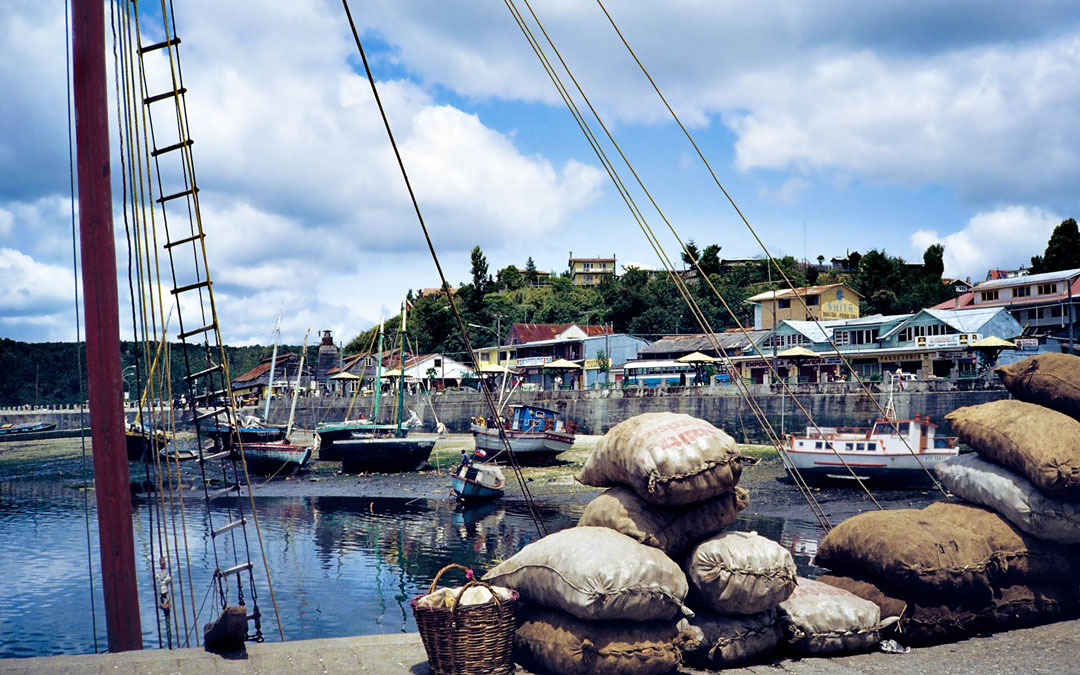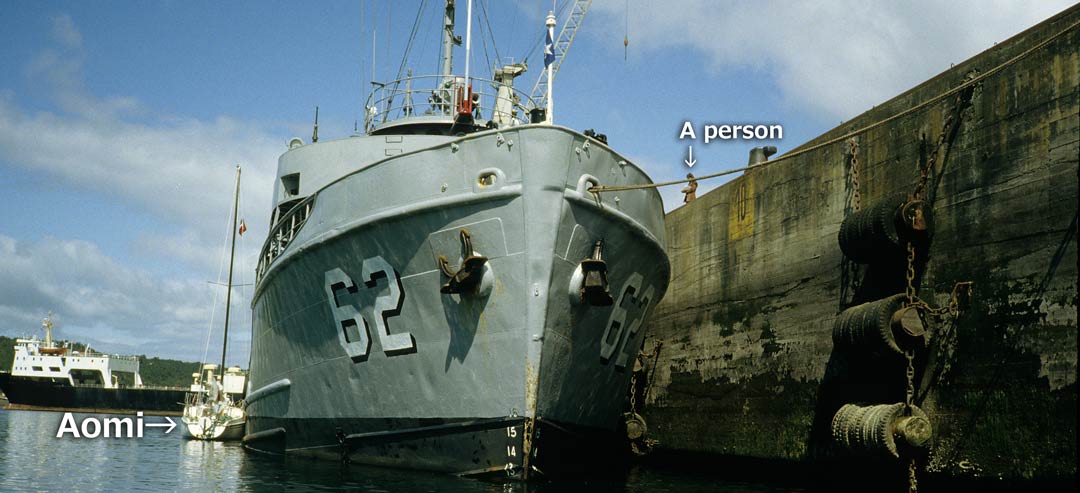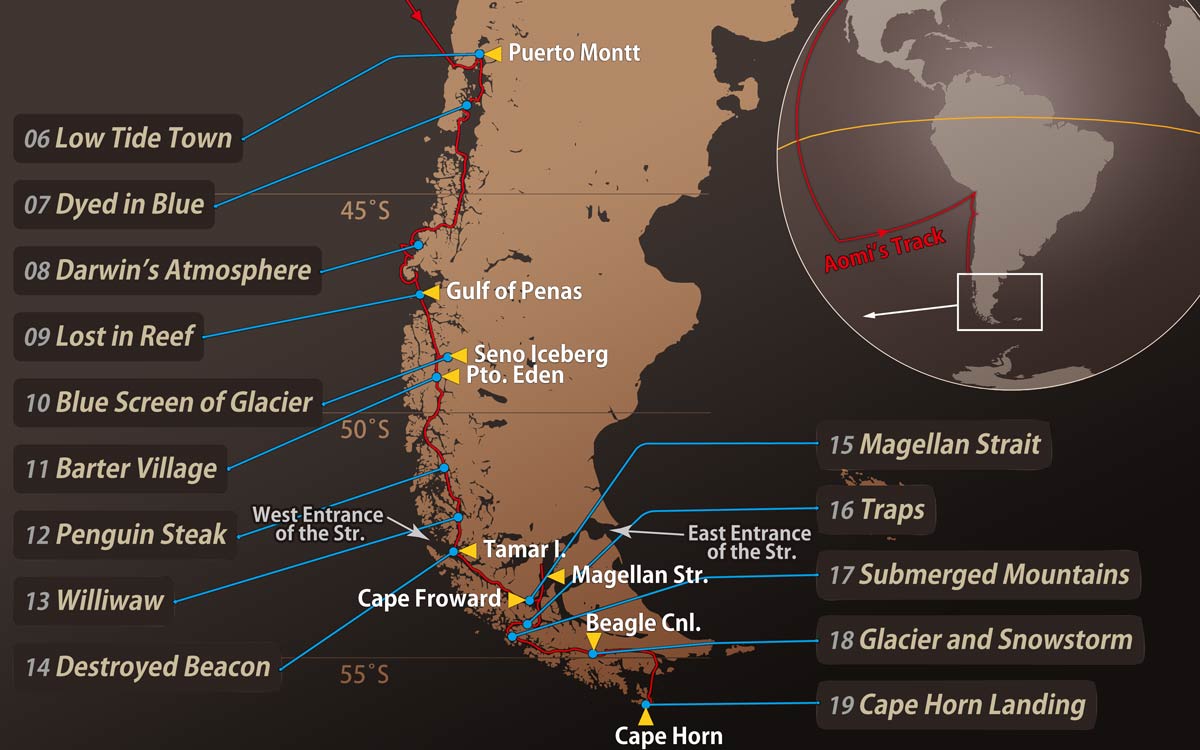06. The Port Where Time Slows
When you enter a new world and your skills are about to be tested, you may experience mixed feelings of fear and hope. Will I succeed? Or will I end up with nothing after pushing the limits of my abilities?
I was busy making final preparations in the northernmost city of the Patagonian Archipelago.

“What an unusual port this is!”
The concrete quay rises above the water like the wall of a three-story building. For small sailboats, it is like a sheer cliff, making it impossible for me to go ashore.
Aomi and I have arrived in Puerto Montt, the northernmost city in the Patagonian Archipelago. Here, the sea level rises and falls by seven meters with the tides.
The harbor is lined with wooden sailing boats carrying potatoes, sheep, and other goods from the neighboring islands. They enter the bay at high tide and eventually settle onto the shoals as the tide goes out.
Then, horse-drawn carts arrive from shore and begin unloading the cargo. These boats are about ten meters long, engine-less, and still powered only by cotton sails, oars, and current.
As I struggle to get ashore, someone from a Chilean navy ship moored at the quay tells me I can bring Aomi alongside and go ashore via the ship’s deck. A ramp connects the ship to the quay.
I am allowed to cross the 44‑meter warship Lautaro as a substitute for a pier and step into Puerto Montt, a city of over 100,000 people.

I take my passport and documents from my backpack, stop at the marine police station, and complete the entry procedures in Spanish, a language I barely know. I also need to stock up on food for the long voyage through the archipelago, a journey that will take several months.
I wander through the city’s Mercado (market), where red potatoes and long-stemmed green onions, both local specialties, are sold. It takes me nearly two days to buy provisions and load them onto Aomi. I have been warned that getting supplies all the way to Punta Arenas would be difficult. The city lies about a thousand kilometers to the south, and inhabited islands are rare along the way.
With a dictionary in hand, I wander the city, occasionally arguing in broken Spanish with shopkeepers. I buy thick wool hats, heavy socks, and gloves, all local specialties. Since Puerto Montt is located at 43 degrees south and I am heading for Cape Horn, more than ten degrees farther south, preparing for the cold is essential.
I also need sufficient anchoring gear, since after leaving Puerto Montt, I will be sailing between islands by day and anchoring in uninhabited bays at night.
Aomi is already equipped with three types of anchors and 300 meters of anchor rope, among other necessities. That is plenty for a small sailboat only 7.5 meters long.
Still, I have heard of williwaws blowing down from the Andes, said to be strong enough to send stones flying. This prompted me to buy extra ropes and shackles at the hardware store.
I also need to repair several sails damaged during the long voyage from Japan. I mend frayed threads, spread the wind-stretched canvas across the cramped cabin, trim it, and sew with my favorite sail palm. It is a large leather thimble worn on the hand.
From here to Cape Horn, the Patagonian Archipelago stretches nearly 1,800 kilometers, its countless islands scattered through a vast, fjord-like region. There are few towns along the way. Beyond charts and Sailing Directions, local knowledge is essential for safe navigation. I carry dozens of charts in my arms over to a navy ship near Aomi and meet an officer in a black uniform with gold buttons.
He gives me detailed advice about dangerous rocks, shoals, and currents along the route. He even invites me to lunch and opens a bottle of wine with a Chilean Navy label. Navigating these island waters safely requires knowledge, skills, and preparations quite different from those needed for open-sea voyages.
On the day I finally finish preparations and get permission from the marine police to depart, a young man with a colorful backpack calls out to me from the quay.
He is an American traveler who has missed the ferry, which runs only a few times a month. He asks me to take him to Punta Arenas. He is in a hurry.
What on earth could he be thinking? Just how determined must he be to hitchhike on a sailboat? It will take more than two months to reach Punta Arenas. Where on tiny Aomi could we even find the space to store enough food and water for one more person? He seems to think we will reach Punta Arenas in just a few days, like on a passenger ship.
Does he realize how slow it is to travel by small sailboat? It is nothing like going by car or taking a safe ferry. I wonder if he has any idea just how hard and hazardous it is to navigate the Patagonian Archipelago in a tiny sailboat. Aomi is only 7.5 meters long, with a mere 3.5‑horsepower engine.
I take the helm and set sail into a sea where the logic of city life loses all meaning. The waters of the Patagonian Archipelago are a primordial world, where you can feel the Earth’s immense power and breathtakingly long history.

Hi! Any questions or suggestions about the content are greatly appreciated.
I’d also love writing tips from native English speakers. Since English isn’t my first language, if you notice any awkward phrases or anything that seems off, please let me know.
Thank you!
E-mail